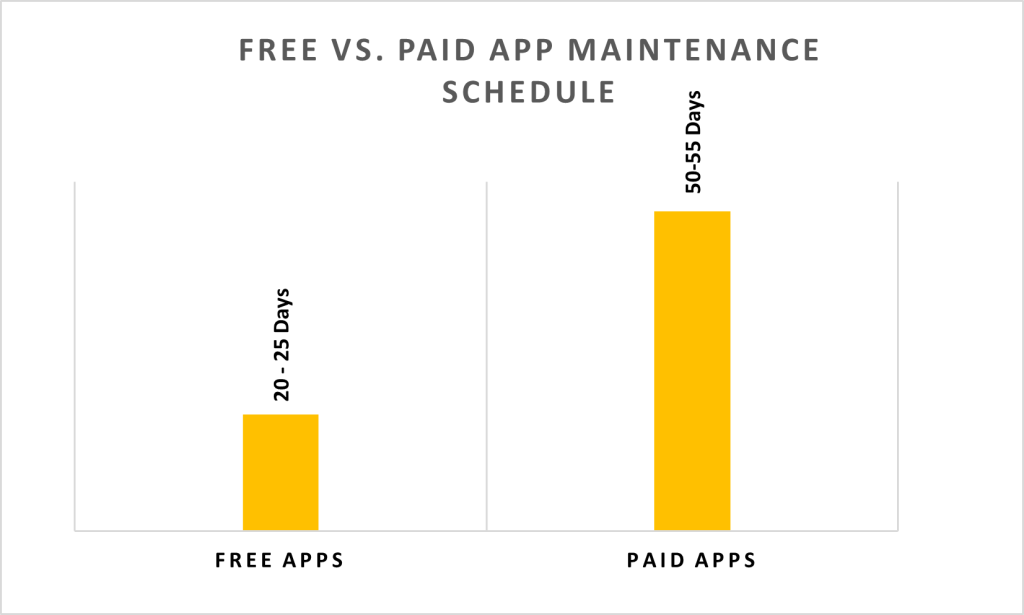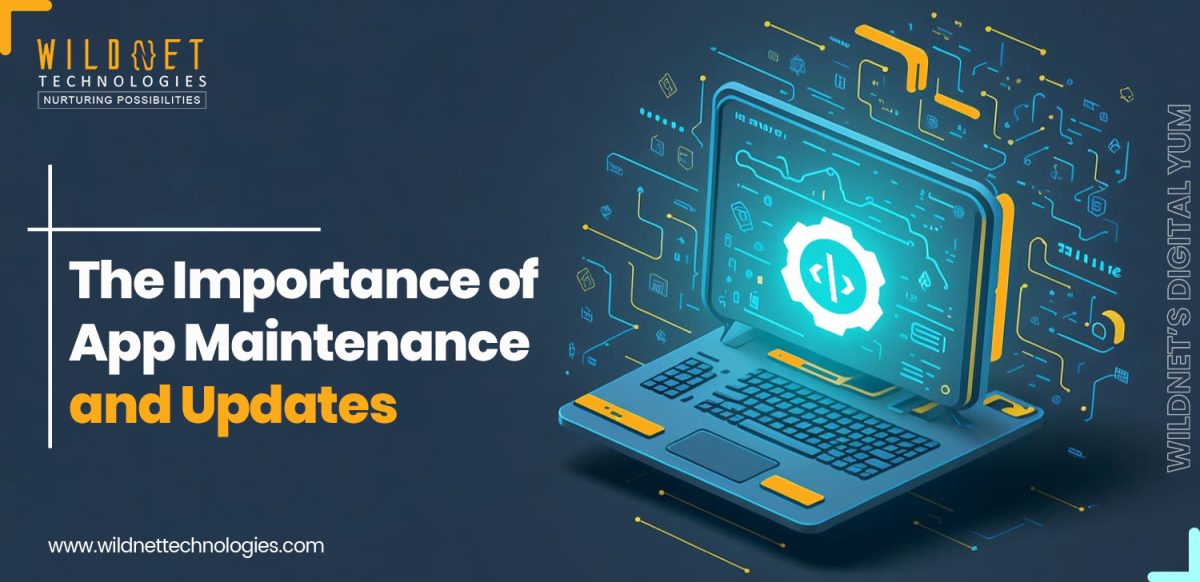Application Maintenance & Updates in 2024: Update or Phase Out! (The complete guide)
Application maintenance and updates are crucial and help your apps stay worthy enough to get more downloads. They keep your apps, be they mobile apps or web apps, up-to-date with the latest technology, features, functionalities, and more.
Today, apps help with almost everything! They become a real-time link between users and businesses. Anyone can use them to shop, check information (email, financial, and more), play games, track shipments, and more from the comfort of their palms!
A few facts:
- Total app revenue (expected) by 2027 is USD 673.8 billion
- 7 million apps were rejected by Apple’s App Store in 2022
- Apple will reject apps without a proper API starting May 1st, 2024
- 28 million apps were rejected by Google’s Play Store in 2023
- In 2024, Google will remove apps without transparency
- Paid app vs. Free app

Thus, applications must have an application maintenance and update schedule to stay relevant, legally, and technologically compliant.
The importance of application maintenance and updates
Let us see eight factors that can motivate businesses to follow through with the maintenance and upgrade of their apps.
1. UI and UX changes:
The UI and UX of an app show its external features and personality. Sometimes, due to unforeseen circumstances, the opinions of the general public sway in such a direction that the current UI and UX of the app do not work!
2. Quality issues:
Either due to a recent upgrade or any changes from the hosting platform (Android and iOS) or the hardware, the quality of the app is not up to par! Poor quality will cause users to be demotivated and uninstall the app.
3. Availability issues:
Maybe the app is not available on a particular platform or device, as each has its own set of requirements. In that case, the app will lose users and receive negative publicity.
4. Security challenges:
The apps have essential data about your users, whether their contact or bank details, while the businesses have user selections and preferences. Hackers and anti-social elements are always looking to break into the app database and steal it.
5. New features:
As your business grows, your offerings (products and/or services) will change, or maybe you just wish to present them in a different light. The app will need an upgrade!
6. Cost effectiveness:
Many new technologies arise every day. Some might lower the app’s expenses, which would be beneficial in the long run.
7. Competitive Edge:
The app represents a business and must stay ahead of its competitors. Any new feature in competing apps needs to be replicated with better branding in your app.
8. ROI Increase:
Ultimately, it all comes down to the return on investment, or ROI, generated by the app. To increase it, a business will do anything!
Now, let us understand it with a few real-world examples.
-
Fleet Management Software
It helps transporters (vendors), producers, and receivers track the shipment. Since the shipment is worth a lot (itself) and can stop manufacturing lines and disrupt the market chain, the supply chain needs to be monitored in real-time.
And the competition is to make the fleet manager software app faster, better, easier, better at geo-location, and cheaper. Examples of fleet management software apps are Fleetio, Samsara, and more.
-
Facilities Management Software, or FM
It helps facility managers or administrators track inventory and ensure that the items needed in the business process are always in good enough stock. The whole business depends on this inventory, so it is imperative.
The competition is to make it interactive, AI-integrated, better at geo-positioning, and cheaper. Examples of facilities management software are Asset Essentials, Hippo CMS, and more.
In every sector of the economy, apps help to conduct business transactions (data sharing, monetary, and more), and thus, they face competition and many of the other challenges mentioned above.
What are Application Maintenance and Updates?
It is a constant process of innovation, evolution, and optimization of the app to ensure that it has the,
- Latest software and hardware compatibility
- Ability to tackle users’ needs
- Legal and privacy compliance compatibility is needed by hosting platforms
- Country- and/or continent-specific compliances.
- Trending features to survive in a competitive market.
Types of Application Maintenance and Upgrades
An app can undergo five different types of maintenance, depending on the goals of the modifications.
-
Predictive:
The backend analyzes the data collected by the app to figure out where the app could be improved and where users could face problems. It is a proactive approach to solving problems before they mount up!
-
Adaptive or Upgrades:
This is where the app adapts to the latest technology, either in hardware (the device on which it is accessed) or software (Android, iOS, Windows, or Mac).
-
Corrective:
This type of maintenance helps correct issues related to the app’s coding, logic, and design. It occurs regularly.
-
Preventive:
This maintenance tackles the app’s security and accessibility challenges, as well as bugs and errors.
-
Emergency:
This type of maintenance is done on an emergency basis, targeting major bugs and security breaches. It is done instantly!
How much does it cost to maintain an app in 2024?
Maintenance is a little expensive in the first year (from the launch of the app), ranging around 15–40% of the development cost. This happens because many changes and modifications occur in the first year.
Application maintenance from the second year onwards costs only 15-20% of the development costs.
Application Maintenance Procedure
Any business can upgrade its app by following the 7 steps below. It is easy, too!
-
Identification of requirements:
A maintenance plan must be created for every maintenance cycle. It should focus on the changes to be carried out, group similar activities, and choose the method to be used.
The app might need a new tech stack (front and back end, platform, hosting), for example,
- iOS -> Swift, Xcode, iOS SDK, UIKit, and more
- Android -> Kotlin, Android SDK, and more
- Hybrid -> Cordova, PhoneGap, and more
- Cross-platform -> Xamarin, Flutter, and more
-
Analyzing and Planning:
Understand the feasibility of changes by valuing them against the developer team’s capabilities and the chosen time slots. Understanding the practicality of the proposed changes is also vital.
“Good Planning -> Success || No planning-> Failure” — Wildnet Technologies
-
Design changes:
If the app is supposed to undergo changes that will be either in the interface or the addition or removal of features, then the development team has to go back to the drawing board. Just like the initial development phase,
- First, the developers will share the new software requirements document, or SRD.
- After approval of the SRD, related wireframes will be made and presented.
- Once the wireframes are finalized, a prototype of the new version of the app will be made.
- Once this prototype is approved, the new app’s minimum viable product, or MVP version, will be developed.
-
Automation:
It would be best to use automation or AI tools to remove the menial or repetitive work involved in maintenance, freeing the developer team to focus on the important parts of it.
Examples of automation tools are Appium, Robotium, and more.
-
Implementation:
This step focuses on carrying out the proposed changes with the requisite specifications. It should be done on a non-production version of the app.
-
Security checks:
There are two main things to be focused on security-wise, and they are:
- SSL checks ensure that the latest secure socket layer or SSL license (used by the app) and that of the hosting platform match. If not, then it needs to be upgraded.
- Encryption on the app prevents data theft and loss. It also prevents data transfer by the user without permission. Thus, the latest encryption should be used.
-
Testing:
Quality analysts, or QAs, will test the newly modified app to verify whether it has all the proposed changes that were the goal of this maintenance cycle.
The final results would either meet the goals or the process would have to be repeated after understanding where it went wrong.
Generating publicity and Gathering Beta testers
If the app is undergoing significant changes, it can even help businesses generate free traction. Interesting, right? Here is how it can be done:
1. Promo Codes:
Promo codes can be offered to allow your loyal users freebies or relaxation in in-app purchases.
2. Blogs:
It is a great article for the business’s blog. Readers, customers, investors, and others will appreciate it. Since it is a long-form write-up, proper details about problems faced, changes made, and results achieved can be shared.
3. Social network:
Using the business’ social media handle to create hype about the new version of the app is an excellent promotional tactic that engages all your followers and more.
4. Push notification:
Using the app’s push notification to share important updates makes your users feel cared for, and they will be ready to download the app once it hits the stores.
Building hype is as crucial as delivering what the hype is about! So, use it to tease your users and viewers, which will garner user attention once you release the new version.
Everyone needs friends, and your users get one through your app. This digital friend (app) helps make their lives easier and quicker by providing them your services and products quickly. Keeping the app updated will increase your ROI and benefit your users!
We, at Wildnet Technologies, understand that app maintenance and updates are as important as developing them. Thus, we provide best-in-class resources with at least 5+ years of experience. We also allow you to pick up these resources on a remote and contractual basis within 48 hours.
We have been in the IT services industry for 17+ years and have had the pleasure of delivering 660+ projects that engaged 8,000+ resources. The result was 60% cost savings for US-based clients and 40% for domestic clients.
Like to read more about us,
- App Development Process: Idea to Launch
- Contractual developers can help you grow exponentially
- Wildnet’s Digital Yum (newsletter from our Thought Leadership)
Contact us now at info@wildnettechnologies.com and make sure your app is state-of-the-art!
Need help ! Contact Us






